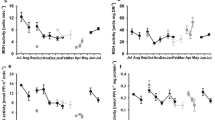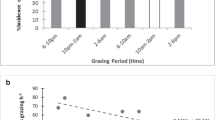Summary
Several biochemical and physiological characteristics of stage V and female adult Calanus hyperboreus from two different depth ranges (0–50 m and 200–500 m) were compared at a time near the peak of the summer pelagic algal bloom in Jones Sound, and again one month later, when the near surface chlorophyll levels were low and most copepods had migrated to their overwintering dephts. For a given stage deep water animals were larger and had higher total lipid levels than did surface animals. Feeding activities, as evidenced by gut pigment contents, may be lower in animals at depth, although potential digestive activities, as expressed in the levels of three digestive enzymes, were not very different either in different stages or at different depths. Respiration rates in animals that had migrated down for the winter were not much lower than in those at the surface although energetic considerations suggest that they may decrease later. Ammonia excretion rates however, changed dramatically. Surface, feeding animals had the highest rates and deep water animals in September had undetectably (<1 ng atom ammonia nitrogen animal-1 · day-1) low rates.
Similar content being viewed by others
References
Barnes H, Blackstock J (1973) Estimation of lipids in marine animals and tissues: detailed investigation of the sulphophosphovanillin method for ‘total’ lipids. J Exp Mar Biol Ecol 12:103–118
Bidigare RR (1983) Nitrogen excretion by marine zooplankton. In: Carpenter EJ, Capone DG (eds) Nitrogen in the marine environment. Academic Press, New York, 385 pp
Bidigare RR, King FD (1981) The measurement of glutamate dehydrogenase activity in Praunus flexuosus and its rôle in the regulation of ammonium excretion. Comp Biochem Physiol B 70:409–413
Bidigare RR, King FD, Biggs DC (1982) Glutamate dehydrogenase (GDH) and respiratory electron-transport-system (ETS) activities in Gulf of Mexico zooplankton. J Plankton Res 4:895–911
Bottrell HH, Robins DB (1984) Seasonal variation in length, dry weight, carbon and nitrogen of Calanus helgolandicus from the Celtic Sea. Mar Ecol Prog Ser 14:259–268
Bradford MM (1971) A rapid and sensitive method for the quantitation of microgram quantities of protein utilizing the principle of protein dye-binding. Anal Biochem 72:248–254
Buchanan RA, Sekerak AD (1982) Vertical distribution of zooplankton in Eastern Lancaster Sound and Western Baffin Bay Canada July–Oct 1978. Arctic 35:41–55
Conover RJ (1965) Notes on the molting cycle, development of sexual characters and sex ratio in Calanus hyperboreus. Crustaceana 8:308–320
Conover RJ, Corner EDS (1968) Respiration and nitrogen excretion by some marine zooplankton in relation to their life cycles. J Mar Biol Assoc UK 48:49–75
Conover RJ, Cota GF (1983) Balance experiments with Arctic zooplankton. In: Gray JS, Cristiansen ME (eds) The marine biology of polar regions, and effects of stress in marine organisms. Proc 18th Eur Mar Biol Symp (in press)
Dawson JK (1978) Vertical distribution of Calanus hyperboreus in the central Arctic Ocean. Limnol Oceanogr 23:950–957
Gatten RR, Sargent JR, Forsberg IEV, O'Hara SCM, Corner EDS (1980) On the nutrition and metabolism of zooplankton. 14. Utilization of lipid by Calanus helgolandicus during maturation and reproduction. J Mar Biol Assoc UK 60:391–400
Grigg H, Bardwell SJ (1982) Seasonal observations on moulting and maturation in stage V copepodites of Calanus finmarchicus from the Firth of Clyde. J Mar Biol Assoc UK 62:315–327
Head EJH, Conover RJ (1983) Induction of digestive enzymes in Calanus hyperboreus. Mar Biol Lett 4:219–231
Head EJH, Wang R, Conover RJ (1984) Comparision of diurnal feeding rhythms in Temora longicornis and Centropages hamatus with digestive enzyme activity. J Plankton Res 6:543–551
King FD (1984) Vertical distribution of zooplankton glutamate dehydrogenase in relation to chlorophyll in the vicinity of the Nantucket Shoals. Mar Biol 79:249–256
Kosobokova KN (1978) Diurhal vertical distribution of Calanus hyperboreus Kroyer and Calanus glacialis Jaschnov in the central Polar Basin. Oceanology 18:476–480
Lee RF (1974) Lipid composition of the copepod Calanus hyperboreas from the Arctic Ocean. Changes with depth and season. Mar Biol 26:313–318
Lee RF, Neverzel JC, Paffenhöfer GA (1971) Importance of wax esters and other lipids in the marine food chain: phytoplankton and copepods. Mar Biol 9:99–108
Longhurst A, Sameoto D, Herman A (1984) Vertical distribution of Arctic zooplankton in summer: eastern Canadian archipelago. J Plankton Res 6:137–168
Mackas DL, Bohrer R (1976) Fluorescence analysis of zooplankton gut contents and investigation of diel feeding patterns. J Exp Mar Biol Ecol 25:77–85
Marshall SM, Orr AP (1958) On the biology of Calanus finmarchicus. 10. Seasonal changes in oxygen consumption. J Mar Biol Assoc UK 37:459–472
Sameoto DD (1984) Vertical distribution of zooplankton biomass and species in northeastern Baffin Bay related to temperature and salinity. Polar Biol 2:213–224
Sargent JR, Gatten RR, Henderson RJ (1981) Lipid biochemistry of zooplankton from high latitudes. Oceanis 7:623–632
Solorzano L (1969) Determination of ammonia in natural waters by the phenol-hypochlorite method. Limnol Oceanogr 14:799–801
Smith JC, Chong CK (1982) Body weight, activities of cytochrome oxidase and electron transport system in the liver of the American plaice Hippoglossoides platessoides. Can these activities serve as indicators of metabolism? Mar Ecol Prog Ser 9:171–179
Tande KS, Hopkins CCE (1981) Ecological investigations of the zooplankton community of Balsfjorden, Northern Norway: the genital system in Calanus finmarchicus and the role of gonad development in overwintering strategy. Mar Biol 63:159–164
Vidal J (1980) Physioecology of zooplankton. 1. Effects of phytoplankton concentration, temperature, and body size on the growth rate of Calanus pacificus and Pseudocalanus sp. Mar Biol 56:111–134
Williams PJL, Jenkinson NW (1982) A transportable microprocessor controlled precise Winkler titration suitable for field station and shipboard use. Limnol Oceanogr 27:576–584
Author information
Authors and Affiliations
Rights and permissions
About this article
Cite this article
Head, E.J.H., Harris, L.R. Physiological and biochemical changes in Calanus hyperboreus from Jones Sound NWT during the transition from summer feeding to overwintering condition. Polar Biol 4, 99–106 (1985). https://doi.org/10.1007/BF00442907
Received:
Accepted:
Issue Date:
DOI: https://doi.org/10.1007/BF00442907




